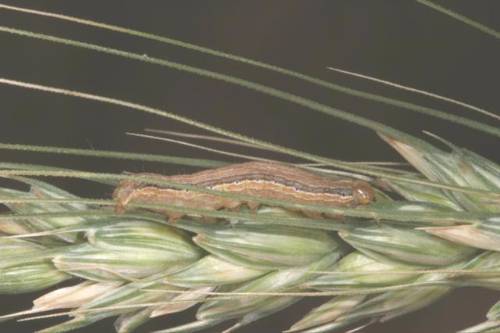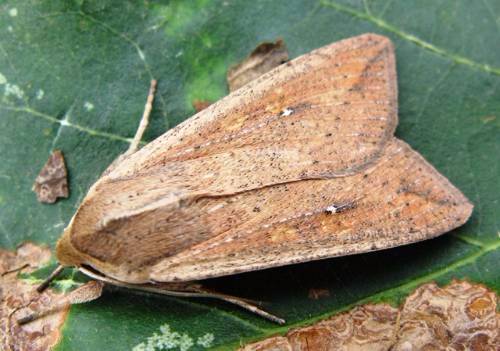True armyworm
Pseudaletia unipuncta
|
Larva on wheat head. |
Adult armyworm moth. |
Armyworms feed on a variety of plants, preferring grasses, and adults lay their eggs in large clusters on rich vegetation. The larvae are green to black with stripes of various colors. The head capsule is medium brown with dark markings. Most damage to wheat in Kansas occurs in southern and eastern areas of the state during warm, moist periods from late April to early June.
Each larva, feeding mostly at night, can consume 43 linear inches of wheat leaf, or the equivalent of three whole plants, in the course of its development. However, 80 percent of this damage occurs during the last three to five days of larval feeding. When leaf feeding is observed, look for larvae curled up on the ground under litter, especially in patches of lodged plants. Treatment is usually not necessary below levels of four or five larvae per foot, but is probably justified at infestations of five to eight per foot depending upon larval matu-rity in relation to crop maturity.
Wheat is likely to suffer yield loss if the flag leaf is destroyed before the soft dough stage is completed. Consequently, the stage of plant development is a factor to consider when making treatment decisions. As wheat plants mature and the leaves dry out, armyworms may feed on beards and clip heads to complete their food requirements. Head clipping in barley is serious and should be prevented, and while it is less likely in wheat, worms should be watched closely if present after heading and forced to feed on the upper parts of plants to complete development. Be aware there also is a danger of migration out of maturing grain fields and into adjacent fields of corn and sorghum.
Please refer to the most recent version of the Wheat Insect Management Guide for control options.
Page last updated 10/30/2013 by J.P. Michaud.

